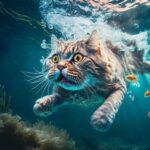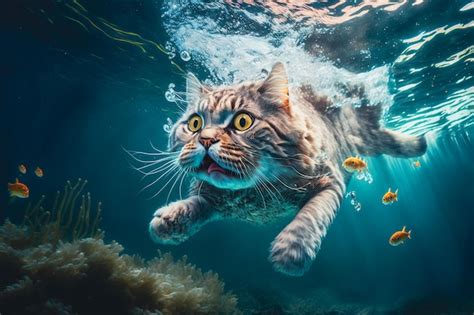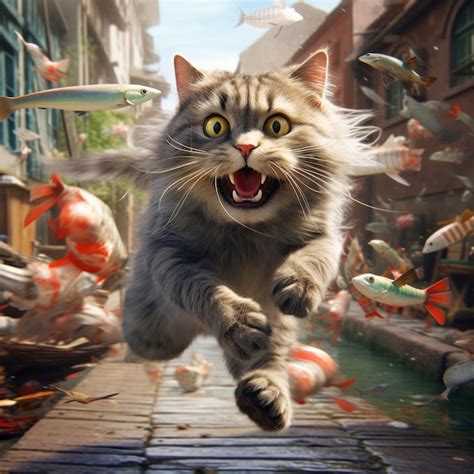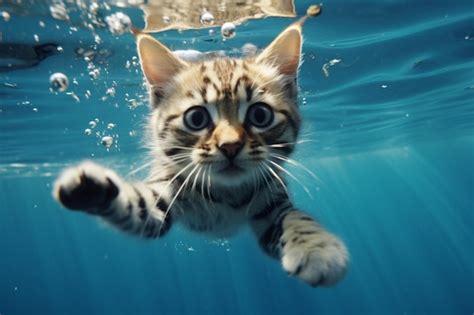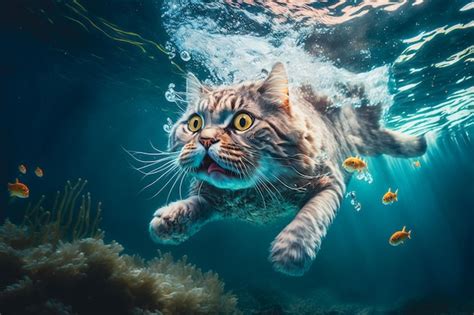
AI-generated videos of cats performing synchronized dives are captivating viewers online, showcasing the rapidly advancing capabilities and sometimes bizarre outputs of artificial intelligence. The videos, described as “unnervingly realistic,” have gained significant traction on social media platforms, blurring the lines between reality and digital fabrication.
The viral sensation highlights how AI tools can now create highly convincing, albeit fictional, scenarios, raising questions about the future of media and the potential for AI-driven content creation. The lifelike quality of these AI-generated cat diving videos underscores both the impressive progress and the potential implications of this technology.
The emergence of these videos also prompts discussions about the ethical considerations and the need for media literacy in an age where distinguishing between authentic and synthetic content is becoming increasingly challenging. As AI continues to evolve, its impact on entertainment, information, and societal perceptions will likely continue to grow.
The AI-generated cat diving videos exemplify the evolving landscape of digital content creation, where artificial intelligence is increasingly capable of producing realistic and engaging simulations. These videos, which depict cats performing synchronized dives with remarkable precision and grace, have captured the attention of a wide audience, sparking both amusement and reflection on the capabilities and implications of AI technology.
The videos have quickly spread across social media platforms, garnering millions of views and sparking discussions about the realism and artistry of AI-generated content. Viewers are often struck by the lifelike movements and expressions of the feline divers, highlighting the sophistication of the AI algorithms used to create these simulations.
“I didn’t realize I needed to see cats doing synchronized diving until just now,” wrote one user on social media, capturing the widespread sentiment of surprise and delight that has accompanied the videos’ viral spread. The videos’ unexpected appeal underscores the power of AI to generate novel and entertaining content that resonates with audiences on an emotional level.
The creation of AI-generated cat diving videos involves a complex process that combines advanced machine learning techniques with creative design. AI algorithms are trained on vast datasets of images and videos of cats, as well as examples of human diving performances. This training enables the AI to learn the nuances of feline anatomy, movement, and behavior, as well as the principles of synchronized diving.
Once the AI is trained, it can generate new videos of cats performing dives that are both realistic and aesthetically pleasing. The AI can control various aspects of the videos, such as the cats’ appearance, the diving environment, and the synchronization of their movements. The result is a seamless blend of reality and artificiality that blurs the lines between what is real and what is simulated.
The AI-generated cat diving videos are not only entertaining but also raise important questions about the future of media and the role of AI in content creation. As AI technology continues to advance, it is becoming increasingly capable of generating realistic and engaging content that can rival human-created works. This raises the possibility that AI could one day replace human artists and content creators in certain fields.
However, it is important to recognize that AI-generated content is not without its limitations. While AI can excel at replicating existing patterns and styles, it often struggles to create truly original or innovative works. AI-generated content also lacks the emotional depth and personal expression that are characteristic of human-created art.
Furthermore, the rise of AI-generated content raises ethical concerns about issues such as copyright, ownership, and the potential for misuse. It is important to develop clear guidelines and regulations to ensure that AI-generated content is used responsibly and ethically.
The AI-generated cat diving videos are just one example of the many ways in which AI is transforming the world around us. As AI technology continues to evolve, it will likely have a profound impact on various aspects of our lives, from entertainment and education to healthcare and transportation. It is important to understand the capabilities and limitations of AI so that we can harness its potential for good while mitigating its risks.
The creation of AI-generated videos has become increasingly accessible, thanks to the development of user-friendly AI tools and platforms. These tools allow individuals with little or no technical expertise to create their own AI-generated content, opening up new possibilities for creativity and expression. However, this increased accessibility also raises concerns about the potential for misuse, such as the creation of deepfakes or the spread of misinformation.
The AI-generated cat diving videos also highlight the importance of media literacy in the digital age. As AI-generated content becomes more sophisticated, it is becoming increasingly difficult to distinguish between what is real and what is fake. It is important for individuals to develop critical thinking skills and to be aware of the potential for deception when consuming online content.
The videos serve as a reminder that the digital world is not always what it seems and that it is important to approach online content with a healthy dose of skepticism. By developing media literacy skills, individuals can protect themselves from misinformation and make informed decisions about the content they consume.
The popularity of AI-generated cat diving videos also reflects a broader cultural trend towards embracing the absurd and the unexpected. In a world that is often characterized by stress and uncertainty, people are drawn to content that is lighthearted, humorous, and escapist. The AI-generated cat diving videos fit this bill perfectly, offering a brief respite from the everyday grind and a reminder that there is still room for wonder and amusement in the world.
The videos also tap into the internet’s long-standing fascination with cats. Cats have been a staple of online culture for many years, appearing in countless memes, videos, and social media posts. The AI-generated cat diving videos offer a fresh and innovative take on this familiar theme, combining the cuteness of cats with the novelty of AI technology.
The AI-generated cat diving videos are a testament to the power of human creativity and ingenuity. While the videos are created by AI, they are ultimately the product of human imagination and design. The creators of these videos have used AI technology to bring their vision to life, creating a unique and engaging form of entertainment.
The videos also demonstrate the potential for collaboration between humans and AI. By working together, humans and AI can create content that is both innovative and meaningful. This collaboration is likely to become increasingly common in the future as AI technology continues to evolve.
The AI-generated cat diving videos are a sign of things to come. As AI technology becomes more sophisticated, we can expect to see even more realistic and engaging AI-generated content in the future. This content will likely have a profound impact on various aspects of our lives, from entertainment and education to healthcare and transportation. It is important to embrace the potential of AI while also being mindful of its limitations and risks.
The future of AI-generated content is bright. With continued research and development, AI technology has the potential to transform the way we create and consume content. This transformation will likely bring about new opportunities and challenges, but it is important to approach the future with optimism and a willingness to adapt.
The AI-generated cat diving videos are a small but significant example of the transformative power of AI. These videos have captured the imagination of millions of people around the world, demonstrating the potential for AI to create content that is both entertaining and thought-provoking. As AI technology continues to evolve, it is important to embrace its potential for good and to work together to ensure that it is used responsibly and ethically.
The emergence of AI-generated content necessitates a broader societal conversation about the definition of art, creativity, and authenticity. As AI tools become increasingly capable of mimicking human artistic styles and generating original content, it challenges traditional notions of authorship and artistic value. This raises questions about whether AI-generated works can be considered art in the same way as human-created works, and what criteria should be used to evaluate their artistic merit.
Moreover, the rise of AI-generated content has implications for the creative industries, potentially disrupting existing business models and creating new opportunities for artists and content creators. While some fear that AI will displace human artists, others believe that it can be a powerful tool for enhancing creativity and expanding artistic possibilities.
The key to navigating this evolving landscape lies in embracing a collaborative approach, where humans and AI work together to create content that is both innovative and meaningful. By leveraging the strengths of both humans and AI, we can unlock new levels of creativity and expression.
The AI-generated cat diving videos also serve as a reminder of the importance of critical thinking and media literacy in the digital age. With the increasing prevalence of AI-generated content, it is becoming more challenging to distinguish between what is real and what is fake. Therefore, it is essential to develop the skills and knowledge necessary to evaluate online content critically and to identify potential sources of misinformation or manipulation.
This includes being aware of the techniques used to create AI-generated content, such as deepfakes and synthetic media, and understanding the potential biases and limitations of AI algorithms. By promoting media literacy and critical thinking, we can empower individuals to make informed decisions about the content they consume and to protect themselves from the harmful effects of misinformation.
The AI-generated cat diving videos represent a fascinating intersection of technology, creativity, and culture. They demonstrate the remarkable capabilities of AI, while also raising important questions about the future of media, art, and society. As AI technology continues to evolve, it is crucial to engage in thoughtful dialogue about its potential benefits and risks, and to work together to ensure that it is used responsibly and ethically.
The videos also spark a conversation about the nature of entertainment and what makes content engaging. In a world saturated with media, it can be difficult to capture people’s attention. The AI-generated cat diving videos succeed in this regard by offering something novel, unexpected, and visually appealing. They combine the familiar appeal of cats with the cutting-edge technology of AI, creating a unique and memorable experience for viewers.
The success of these videos suggests that there is a growing appetite for content that is both innovative and entertaining. As AI technology becomes more accessible, we can expect to see even more creative and imaginative applications of AI in the entertainment industry.
The AI-generated cat diving videos also highlight the importance of ethical considerations in the development and deployment of AI technology. As AI systems become more powerful and sophisticated, it is crucial to ensure that they are used in a responsible and ethical manner. This includes addressing issues such as bias, fairness, transparency, and accountability.
The AI-generated cat diving videos, while seemingly harmless, can serve as a starting point for discussing these broader ethical issues. By engaging in open and honest conversations about the potential risks and benefits of AI, we can help to shape the future of this technology in a way that benefits society as a whole.
The development of AI-generated content also raises questions about intellectual property rights. Who owns the copyright to an AI-generated work? Is it the developer of the AI algorithm, the user who provides the input data, or the AI itself? These are complex legal and ethical questions that need to be addressed as AI technology continues to evolve.
The AI-generated cat diving videos, while not directly implicated in any copyright disputes, can serve as a case study for exploring these issues. By examining the legal and ethical implications of AI-generated content, we can develop frameworks for protecting intellectual property rights and ensuring that AI technology is used in a fair and equitable manner.
The AI-generated cat diving videos also underscore the importance of education and training in the age of AI. As AI technology becomes more prevalent in the workplace, it is crucial for individuals to develop the skills and knowledge necessary to work alongside AI systems. This includes skills such as data analysis, critical thinking, problem-solving, and communication.
The AI-generated cat diving videos, while not directly related to education and training, can serve as a catalyst for discussions about the need for lifelong learning and skills development in the face of rapid technological change. By investing in education and training, we can empower individuals to thrive in the age of AI and to contribute to a more innovative and prosperous society.
Frequently Asked Questions (FAQ)
- What are AI-generated cat diving videos?
AI-generated cat diving videos are videos created using artificial intelligence (AI) that depict cats performing synchronized diving routines. These videos are not real but are computer-generated simulations that mimic the appearance and movements of real cats and divers. The AI is trained on vast datasets of images and videos of cats and diving, enabling it to create lifelike and entertaining simulations.
- How are these AI-generated videos made?
The videos are made using advanced machine-learning techniques. AI algorithms are trained on large datasets of cat images, videos, and diving performances. Once trained, the AI can generate new videos by controlling aspects like the cat’s appearance, the diving environment, and synchronized movements. The AI blends reality and artificiality to create a seamless simulation.
- Why are these videos so popular?
These videos are popular for several reasons. First, they combine two elements that are highly engaging online: cats and novelty. The videos are often humorous and surprising, offering a lighthearted escape. Second, they showcase the impressive capabilities of AI, sparking curiosity and discussion about the future of this technology. Finally, they tap into the internet’s love for absurd and unexpected content.
- What are the ethical concerns surrounding AI-generated content like these videos?
Ethical concerns include the blurring of reality and fiction, which can make it difficult for viewers to distinguish between real and fake content. This raises issues about misinformation and the potential for manipulation. Additionally, questions arise about copyright, ownership, and the potential displacement of human artists and content creators. It is crucial to develop guidelines and regulations to ensure AI is used responsibly.
- What does the popularity of these videos say about the future of AI and media?
The popularity of AI-generated cat diving videos indicates that AI will continue to play a significant role in the future of media. AI is becoming increasingly capable of generating realistic and engaging content, opening up new possibilities for entertainment, education, and other fields. However, it also underscores the need for media literacy and critical thinking to navigate the evolving digital landscape. AI is likely to transform how content is created and consumed, necessitating ongoing adaptation and ethical consideration.
The AI-generated cat diving videos also bring to light the ongoing debate surrounding AI’s impact on jobs, particularly in creative fields. While these videos might seem like a harmless form of entertainment, they represent a broader trend of AI taking over tasks previously performed by humans. This raises concerns about potential job displacement and the need for workforce retraining.
The question of whether AI can truly be creative is also relevant. While AI can mimic existing styles and generate novel combinations of elements, it lacks the emotional depth and personal experiences that often inform human creativity. Some argue that AI-generated content is merely derivative, lacking the originality and artistic vision of human-created works.
Despite these concerns, AI also presents opportunities for artists and content creators. AI tools can be used to enhance creativity, automate tedious tasks, and explore new artistic possibilities. By embracing AI as a collaborator rather than a competitor, artists can unlock new levels of innovation and expression.
The AI-generated cat diving videos are a prime example of how AI can be used to create content that is both entertaining and thought-provoking. They demonstrate the potential of AI to generate novel and engaging experiences, while also raising important questions about the ethical and societal implications of this technology. As AI continues to evolve, it is crucial to engage in ongoing dialogue about its potential benefits and risks, and to work together to ensure that it is used responsibly and ethically.
The videos also highlight the importance of distinguishing between entertainment and reality in the digital age. While these videos are clearly fictional, other forms of AI-generated content, such as deepfakes, can be used to create realistic but false depictions of real people and events. This raises concerns about the potential for misinformation and manipulation.
To combat this, it is essential to promote media literacy and critical thinking skills. Individuals need to be able to evaluate online content critically, identify potential sources of bias, and recognize the signs of AI-generated manipulation. Education and awareness campaigns can play a crucial role in equipping people with the tools they need to navigate the digital landscape safely and responsibly.
The AI-generated cat diving videos are a reminder that the digital world is not always what it seems. It is important to approach online content with a healthy dose of skepticism and to be aware of the potential for deception. By developing media literacy skills and promoting critical thinking, we can protect ourselves from misinformation and ensure that AI technology is used for good.
The discussion surrounding AI-generated content also needs to address the issue of bias. AI algorithms are trained on data, and if that data is biased, the AI will likely perpetuate those biases in its output. This can lead to AI-generated content that is discriminatory or offensive.
To mitigate this risk, it is crucial to ensure that AI training data is diverse and representative. Developers need to be aware of potential biases in their data and take steps to address them. Additionally, AI algorithms should be designed to be transparent and explainable, allowing users to understand how the AI is making decisions.
The AI-generated cat diving videos, while not inherently biased, can serve as a starting point for discussing the broader issue of bias in AI. By raising awareness of this issue and promoting responsible AI development practices, we can help to ensure that AI technology is used in a fair and equitable manner.
The AI-generated cat diving videos are a fascinating example of the intersection of technology, creativity, and culture. They demonstrate the remarkable capabilities of AI, while also raising important questions about the future of media, art, and society. As AI technology continues to evolve, it is crucial to engage in thoughtful dialogue about its potential benefits and risks, and to work together to ensure that it is used responsibly and ethically. These videos serve as a reminder of the power of AI to both entertain and challenge us, and they highlight the importance of navigating this rapidly changing landscape with caution and foresight.





